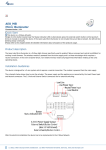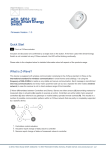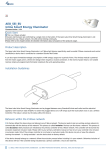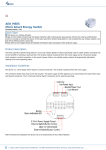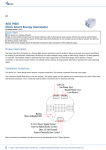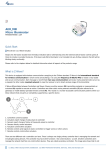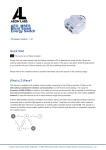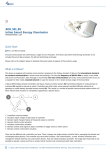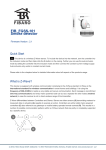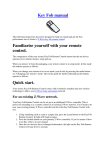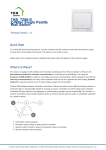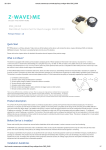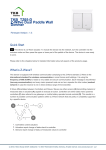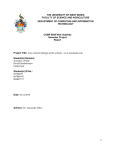Download Z-Wave Aeon Labs Clamp Power Meter
Transcript
Image not readable or empty images/manufacturers/aeon%20labs%20logo.png AEO_HEM2 Z-Wave Clamp Power Meter 2nd Generation - two clamps max. 60 Ampere Firmware Version : 1.5 Quick Start S This device is a Z-Wave Sensor. Single click the little button on the backside to include or exclude the device. Please refer to the chapters below for detailed information about all aspects of the products usage. What is Z-Wave? This device is equipped with wireless communication complying to the Z-Wave standard. Z-Wave is the international standard for wireless communication in smart homes and buildings. It is using the frequency of 868.42 MHz to realize a very stable and secure communication. Each message is reconfirmed (two-way communication) and every mains powered node can act as a repeater for other nodes (meshed network) in case the receiver is not in direct wireless range of the transmitter. Z-Wave differentiates between Controllers and Slaves. Slaves are either sensors (S) transmitting metered or measured data or actuators (A) capable to execute an action. Controllers are either static mains powered controllers (C) also referred to as gateways or mobile battery operated remote controls (R). This results in a number of possible communication patterns within a Z-Wave network that are partly or completely supported by a specific device. 1. Controllers control actuators (c) 2012 Z-Wave Europe GmbH, Goldbachstr. 13, 09337 Hohenstein-Ernstthal, Germany, All rights reserved, www.zwaveeurope.com - pp 1 2. 3. 4. 5. 6. 7. Actuators report change of status back to controller Sensors report change of status of measured values to controller Sensors directly control actuators Actuators control other actuators Remote controls send signals to static controllers to trigger scenes or other actions Remote controls control other actuators. There are two different role a controller can have. There is always one single primary controller that is managing the network and including/excluding devices. The controller may have other functions - like control buttons - as well. All other controllers don't manage the network itself but can control other devices. They are called secondary controllers. The image also shows that its not possible to operate a sensor just from a remote control. Sensors only communicate with static controllers. Product description The Aeon Labs Smart Energy Monitor is a low-cost energy monitor for the entire home. It can wirelessly report immediate wattage and kWh usage to central control point gateways and can be easily installed. Installed in an electricity box, the energy meter will monitor the total consumption of electricity used by an entire building. And its intelligent clamps will report that energy use back to your control point, in watts or kilowatt-hours, and in real time. So you can see how much electricity you really use and when you use it. The main body is anchored using a back mount. The device is powered from a normal AC power supply. The device has two clamps and reports W and kWH (up to 60 Ampere). Before Device is installed Please read carefully the enclosed user manual before installation of the radio-actuator, in order to ensure an error-free functioning. ATTENTION: only authorized technicians under consideration of the country-specific installation guidelines/norms may do works with 230?Volt mains power. Prior to the assembly of the product, the voltage network has to be switched off and ensured against re-switching. The product is permitted only for proper use as specified in the user manual. Any kind of guarantee claim has to be forfeited if changes, modifications or painting are undertaken. The product must be checked for damages immediately after unpacking. In the case of damages, the product must not be operated in any case. If a danger-free operation of the equipment cannot be assured, the voltage supply has to be interrupted immediately and the equipment has to be protected from unintended operation. Installation Guidelines (c) 2012 Z-Wave Europe GmbH, Goldbachstr. 13, 09337 Hohenstein-Ernstthal, Germany, All rights reserved, www.zwaveeurope.com - pp 2 The installation of your Aeotec Home Energy Meter has two major parts: the installation of the meter into your Z-Wave network, and the installation of it into your AC mains electricity box. The electrical installation of your meter into your circuit box should only be done a licensed electrician with knowledge and understanding of electrical systems and electrical safety. You can perform the second half of the installation process, linking the meter with your Z-Wave network, yourself. Important: Turn the main breaker off and open the main circuit box panel. Clip clamps of the meter around the incoming electricity cables that connect to the main circuit breaker. Connect the clamp to the meter using a Clamp Connector. Connect the AC Wire to the meter using the AC Wire Connector.(option) Insert one of AC Power exposed wires into one of the neutral bus terminals and the other exposed wire into the live terminals coming from the main circuit breaker. Replace the main circuit box panel. Turn the main breaker back on. If the circuit boxes is made of metal the radio signal strength may be reduced. In this situation it is recommended that the main body of the meter be affixed outside the circuit box. This will improve the radio signal strength. The Home Energy Meter G2 has been weatherized to the international IP44 standard so that it is resistant to rain and snow when placed vertically with the wires protruding from the bottom of the unit. To place the Home Energy Meter: Slip open the backing plate from the back of your meter. Affix the plate to the selected wall space using the provided screws. Attach your meter to the backing plate. After an electrician connects your Home Energy Meter to your electrical mains, you should include the meter into your Z-Wave network. Behavior within the Z-Wave network I On factory default the device does not belong to any Z-Wave network. The device needs to join an existing wireless network to communicate with the devices of this network. This process is called Inclusion. Devices can also leave a network. This process is called Exclusion. Both processes are initiated by the primary controller of the Z-Wave network. This controller will be turned into exclusion respective inclusion mode. Please refer to your primary controllers manual on how to turn your controller into inclusion or exclusion mode. Only if the primary controller is in inclusion or exclusion mode, this device can join or leave the network. Leaving the network - i.e. being excluded - sets the device back to factory default. If the device already belongs to a network, follow the exclusion process before including it in your network. Otherwise inclusion of this device will fail. If the controller being included was a primary controller, it has to be reset first. Single click the little button on the backside one time to include or exclude the device. Operating the device (c) 2012 Z-Wave Europe GmbH, Goldbachstr. 13, 09337 Hohenstein-Ernstthal, Germany, All rights reserved, www.zwaveeurope.com - pp 3 The Aeotec Home Energy Meter can report wattage energy usage or kWh energy usage to a control point when requested. If this function is supported by the controller point, the energy consumption will be displayed in the user interface of the control point. (The specific Z-Wave commands supporting energy monitoring are the Meter Command Class) Node Information Frame NI The Node Information Frame is the business card of a Z-Wave device. It contains information about the device type and the technical capabilities. The inclusion and exclusion of the device is confirmed by sending out a Node Information Frame. Beside this it may be needed for certain network operations to send out a Node Information Frame. A single click on the little button on the backside sends a Node Information Frame. Associations A Z-Wave devices control other Z-Wave devices. The relationship between one device controlling another device is called association. In order to control a different device, the controlling device needs to maintain a list of devices that will receive controlling commands. These lists are called association groups and they are always related to certain events (e.g. button pressed, sensor triggers, ...). In case the event happens all devices stored in the respective association group will receive a common wireless command. Association Groups: 1 Receiver of all Reports (max. nodes in group: 5) Configuration Parameters Z-Wave products are supposed to work out of the box after inclusion, however certain configuration can adapt the function better to user needs or unlock further enhanced features. IMPORTANT: Controllers may only allow to configure signed values. In order to set values in the range 128 … 255 the value sent in the application shall be the desired value minus 256. For example: to set a parameter to 200? it may be needed to set a value of 200 minus 256 = minus 56. In case of two byte value the same logic applies: Values greater than 32768 may needed to be given as negative values too. (c) 2012 Z-Wave Europe GmbH, Goldbachstr. 13, 09337 Hohenstein-Ernstthal, Germany, All rights reserved, www.zwaveeurope.com - pp 4 If the reverse clamping pliers, negative power is detected. (Parameter Number 2, Parameter Size 1) Value Description 0 Disabled (Default) 1 Enabled Automated Report only when power is changed (Parameter Number 3, Parameter Size 1) Value Description 0 Disabled (Default) 1 Enabled Minimum Change to send Report (Watt) for the whole HEM (Parameter Number 4, Parameter Size 2) The value represents the minimum change in Wattage for a Report to be sent . Value Description 0 — 32000 W (Default 50) Minimum Change to send Report (Watt) for clamp 1 (Parameter Number 5, Parameter Size 2) The value represents the minimum change in Wattage for a Report to be sent . Value Description 0 — 32000 W (Default 50) Minimum Change to send Report (Watt) for clamp 2 (Parameter Number 6, Parameter Size 2) The value represents the minimum change in Wattage for a Report to be sent . Value Description 0 — 32000 W (Default 50) Minimum Change to send Report (Watt) for clamp 3 (Parameter Number 7, Parameter Size 2) The value represents the minimum change in Wattage for a Report to be sent . Value Description 0 — 32000 W (Default 50) (c) 2012 Z-Wave Europe GmbH, Goldbachstr. 13, 09337 Hohenstein-Ernstthal, Germany, All rights reserved, www.zwaveeurope.com - pp 5 Minimum Change to send Report (%) for the whole HEM (Parameter Number 8, Parameter Size 1) The value represents the minimum change in Watage Percent for a report to be sent Value Description 0 — 255 % (Default 10) Minimum Change to send Report (%) for clamp 1 (Parameter Number 9, Parameter Size 1) The value represents the minimum change in Watage Percent for a report to be sent Value Description 0 — 255 % (Default 10) Minimum Change to send Report (%) for clamp 2 (Parameter Number 10, Parameter Size 1) The value represents the minimum change in Watage Percent for a report to be sent Value Description 0 — 255 % (Default 10) Minimum Change to send Report (%) for clamp 3 (Parameter Number 11, Parameter Size 1) The value represents the minimum change in Watage Percent for a report to be sent Value Description 0 — 255 % (Default 10) Enable /disable reporting CRC-16 Encapsulation Command (Parameter Number 13, Parameter Size 1) Value Description 0 Disabled (Default) 1 Enabled Set 101-103 to default (Parameter Number 100, Parameter Size 1) Value Description (c) 2012 Z-Wave Europe GmbH, Goldbachstr. 13, 09337 Hohenstein-Ernstthal, Germany, All rights reserved, www.zwaveeurope.com - pp 6 Report type send in Reporting Group 1 (Parameter Number 101, Parameter Size 4) Defines the type of report sent for the Reporting Group 1. Value Description 1 Battery Report 2 MultiSensor Report for the whole device 4 Meter Report for Watt for the whole device 8 Meter Report for kWh for the whole device (Default) 256 Meter Report for Watt for clamp 1 512 Meter Report for Watt for clamp 2 1024 Meter Report for Watt for clamp 3 2048 Meter Report for kWh for clamp 1 4096 Meter Report for Watt for clamp 2 8192 Meter Report for kWh for clamp 3 Report Type send in Reporting Group 2 (Parameter Number 102, Parameter Size 4) Defines the type of report sent for the Reporting Group 2. Value Description 1 Battery Report 2 MultiSensor Report for the whole device 4 Meter Report for Watt for the whole device 8 Meter Report for kWh for the whole device 256 Meter Report for Watt for clamp 1 512 Meter Report for Watt for clamp 2 1024 Meter Report for Watt for clamp 3 2048 Meter Report for kWh for clamp 1 4096 Meter Report for Watt for clamp 2 8192 Meter Report for kWh for clamp 3 (c) 2012 Z-Wave Europe GmbH, Goldbachstr. 13, 09337 Hohenstein-Ernstthal, Germany, All rights reserved, www.zwaveeurope.com - pp 7 Report Type send in Reporting Group 3 (Parameter Number 103, Parameter Size 4) Defines the type of report sent for the Reporting Group 3. Value Description 1 Battery Report 2 MultiSensor Report for the whole device 4 Meter Report for Watt for the whole device 8 Meter Report for kWh for the whole device 256 Meter Report for Watt for clamp 1 512 Meter Report for Watt for clamp 2 1024 Meter Report for Watt for clamp 3 2048 Meter Report for kWh for clamp 1 4096 Meter Report for Watt for clamp 2 8192 Meter Report for kWh for clamp 3 Set 111-113 to default (Parameter Number 110, Parameter Size 1) Value Description Send Interval for Reporting Group 1 (Parameter Number 111, Parameter Size 1) Defines the time interval when the defined report of Reporting Group 1 is sent out. Value Description 0 — 255 Seconds (Default 1) Send Interval for Reporting Group 2 (Parameter Number 112, Parameter Size 1) Defines the time interval when the defined report of Reporting Group 2 is sent out. Value Description 0 — 255 Seconds (Default 1) Send Interval for Reporting Group 3 (Parameter Number 113, Parameter Size 1) Defines the time interval when the defined report of Reporting Group 3 is sent out. (c) 2012 Z-Wave Europe GmbH, Goldbachstr. 13, 09337 Hohenstein-Ernstthal, Germany, All rights reserved, www.zwaveeurope.com - pp 8 Value Description 0 Seconds Partner ID (Parameter Number 200, Parameter Size 1) (0= Aeon Labs Standard Product, 1= AT&T). Value Description Enable/disable Configuration Locked (Parameter Number 252, Parameter Size 1) 0 =disable, 1 = enable Value Description 0 0 = disabled (Default) 1 1 = enabled Device Tag (Parameter Number 254, Parameter Size 2) Value Description Reset (Parameter Number 255, Parameter Size 1) Reset configuration set up to default setting Value Description Command Classes Supported Command Classes Multi Channel (version 3) Basic (version 1) Association (version 1) Version (version 1) Meter (version 3) Configuration (version 1) Manufacturer Specific (version 2) Technical Data (c) 2012 Z-Wave Europe GmbH, Goldbachstr. 13, 09337 Hohenstein-Ernstthal, Germany, All rights reserved, www.zwaveeurope.com - pp 9 IP Rating IP 44 Frequency 868.42 MHz (SRD Band) Wireless Range up to 100 m outside, on average up to 20 m inside buildings Explorer Frame Support Yes SDK 4.55.00 Device Type Slave with routing capabilities Generic Device Class Meter Specific Device Class Simple Meter Routing Yes FLiRS No Firmware Version 1.5 Explanation of Z-Wave specific terms Controller — is a Z-Wave device with capabilities to manage the network. Controllers are typically Gateways, Remote Controls or battery operated wall controllers. Slave — is a Z-Wave device without capabilities to manage the network. Slaves can be sensors, actuators and even remote controls. Primary Controller — is the central organizer of the network. It must be a controller. There can be only one primary controller in a Z-Wave network. Inclusion — is the process of bringing new Z-Wave devices into a network. Exclusion — is the process of removing Z-Wave devices from the network. Association — is a control relationship between a controlling device and a controlled device. Wakeup Notification — is a special wireless message issued by a Z-Wave device to annonces that is is able to communicate. Node Information Frame — is a special wireless message issued by a Z_Wave device to announce its capabilities and functions. Disposal Guidelines The product does not contain hazardous chemicals. Do not dispose of electrical appliances as unsorted municipal waste, use separate collection facilities. Contact your local government for information regarding the collection systems available. If electrical appliances are disposed of in landfills or dumps, hazardous substances can leak into the groundwater and get into the food chain, damaging your health and well-being. (c) 2012 Z-Wave Europe GmbH, Goldbachstr. 13, 09337 Hohenstein-Ernstthal, Germany, All rights reserved, www.zwaveeurope.com - pp 10










